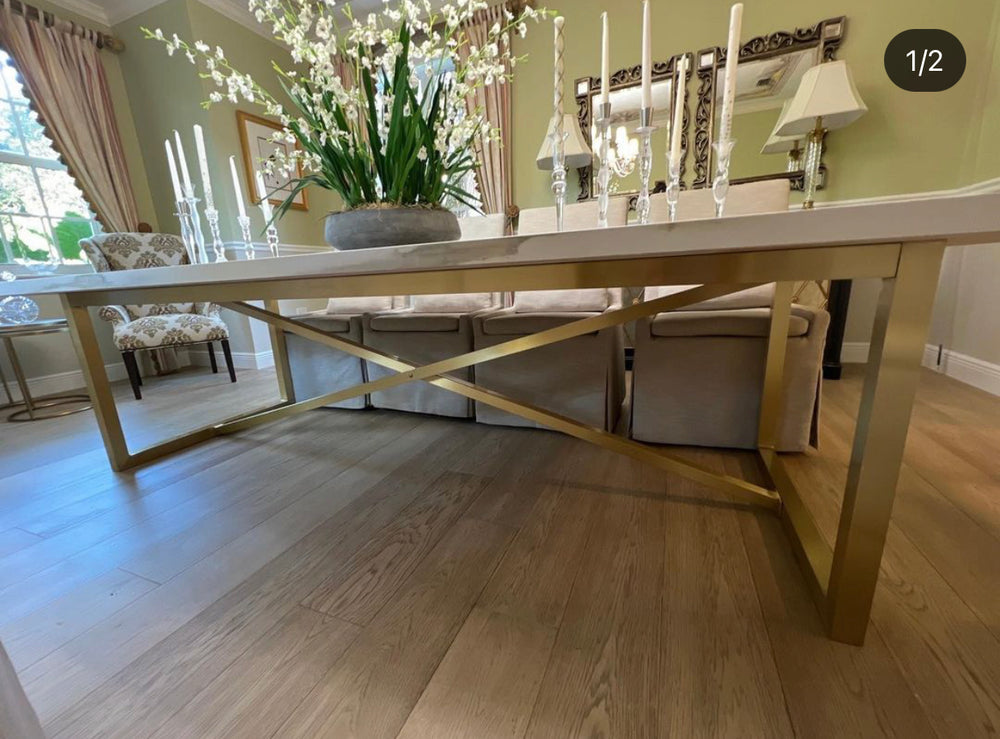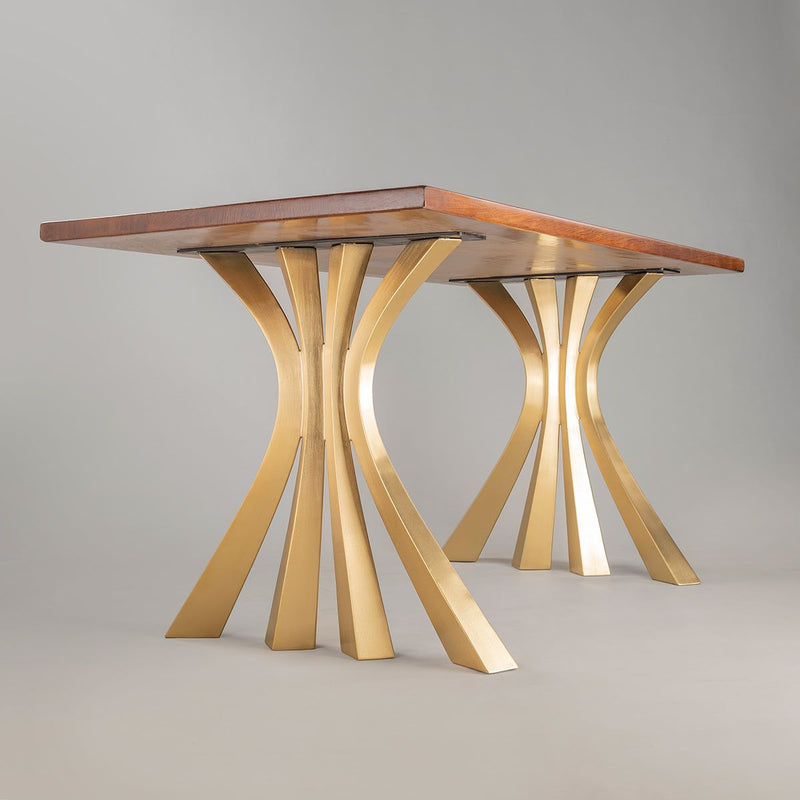Dining Room Table Legs: What to Take into consideration Before You Get
Dining Room Table Legs: What to Take into consideration Before You Get
Blog Article
Selecting the Perfect Dining Table: What Styles Job Best for Your Home?
Selecting the suitable eating table for your home can be a nuanced process that stabilizes appearances and capability. Whether your room leans in the direction of traditional style, modern-day minimalism, rustic charm, or industrial stylish, the range of styles available can deal with diverse preferences. Each style uses special advantages and obstacles that can either improve or disrupt your dining area's consistency. Understanding exactly how different materials, shapes, and dimensions communicate with your existing style is important. To navigate these selections properly and locate a table that genuinely matches your home, think about the following elements in detail.
Evaluating Your Room
Assessing the dimensions and design of your eating location is a crucial very first step in picking the ideal table. Begin by gauging the length and size of the room, accounting for entrances, home windows, and various other architectural functions that might affect table placement. This makes certain that your table not just fits however additionally permits comfy motion around it.
Consider the variety of people you commonly entertain. A table needs to fit your family's day-to-day requirements while offering adequate flexibility for periodic guests. As a regulation of thumb, allocate at the very least 24 inches of table size each to make certain a comfy eating experience.
It's additionally vital to maintain ideal clearance around the table. Ideally, there must be at least 36 inches in between the table side and walls or other furnishings, allowing easy gain access to and movement. For areas where chairs with arms or extra storage space units like buffets are entailed, boosting this clearance to 48 inches is suggested.
Lights and ambience play considerable duties too. Guarantee that your table lines up with existing illumination components or prepare for ample lighting options. This detailed spatial evaluation warranties that your dining table not just fits physically however additionally harmonizes with your area's general capability and visual.
Popular Table Styles

Conventional dining tables often feature elaborate details, bent legs, and abundant timber finishes, evoking a sense of timeless sophistication. They are perfect for homes with timeless design or those looking to add a touch of elegance to their dining area.
Modern eating tables prioritize simplicity and tidy lines, commonly incorporating materials like glass and steel. These tables are excellent for modern rooms, providing a sleek and uncluttered appearance that matches minimalist layout viewpoints.
Rustic dining tables, on the various other hand, highlight all-natural materials and a handcrafted appearance - dining room table legs. They commonly include recovered timber and a troubled coating, producing a warm and welcoming ambience. These tables work well in farmhouse-style homes or those seeking a comfy, natural feel
Industrial dining tables integrate raw materials such as metal and wood, commonly showcasing a practical aesthetic. This design is fit for loft spaces or urban areas, including a touch of tough appeal and sturdiness to the eating experience.
Each style supplies unique benefits, making it important to choose one that straightens with your home's general design and your personal choices.
Product Selections
When selecting a dining table, the choice of material plays an essential function in determining both the table's looks and performance. Timber, steel, glass, and composite materials each offer one-of-a-kind benefits and obstacles, making it imperative to align the product with your home's decor and way of living requirements.
Wood is an ageless and versatile choice, offered in ranges such as oak, walnut, and mahogany. Recognized for its sturdiness and heat, timber enhances both conventional and modern insides. However, it calls for regular maintenance to avoid scrapes and bending.
Steel tables, typically crafted from stainless-steel, aluminum, or wrought iron, are praised for their modern charm and effectiveness. They are especially suited for industrial or minimal settings but can be susceptible to dents and might feel cool to the touch.
Glass dining tables bring an air of elegance and visibility, perfect for smaller sized rooms as they produce an illusion of even more space. While easy to tidy, glass can be prone to smudges and requires careful handling to prevent chips and fractures.
Composite products, such as MDF and plywood, deal economical and adjustable remedies, though they might lack the durability of natural products. Choosing the ideal material ensures your eating table is both a functional property and an aesthetic pleasure.
Sizes And Shape Considerations
After figuring out the proper material for your table, the following factor to consider is selecting the right sizes and shape to match your room. The shape of the table substantially more tips here affects the space's aesthetic and performance. Rectangular tables, one of the most usual shape, are optimal for larger rooms and can fit a greater number of guests. They likewise enable a more official eating experience. Conversely, rounded tables cultivate a sense of intimacy and are excellent for smaller sized eating areas, encouraging conversation by eliminating edges and making everybody feel similarly consisted of.
Dimension is equally crucial and should be determined by both the area's measurements and the number of people you intend to seat routinely. Generally of thumb, designate at the very least 24 inches of table size per person to make certain comfortable eating. In addition, take into consideration the table's clearance room: there should be at the very least 36 inches between the table side and the wall surfaces or other furnishings. This guarantees that restaurants can move conveniently without feeling cramped. Extending tables provide versatility if you regularly organize bigger gatherings, giving additional seating when needed without occupying extra room daily. Choosing the appropriate form and dimension guarantees both practicality and aesthetic consistency in your eating area.
Matching Your Style
Picking an eating table that balances with your existing decoration is critical in producing a natural and inviting space. A streamlined, minimal table with clean lines is ideal for a modern-day home, while a vintage, elaborate table matches a much more standard setup.
If your decor includes warm tones and natural materials, Get the facts consider a wood table to improve the natural feeling. Alternatively, a glass or metal table may be a lot more ideal in an area dominated by cool shades and industrial aspects.
Texture plays a vital role. A rough-hewn, redeemed timber table can include personality to a rustic space, while a sleek marble surface area can boost an extravagant eating location. Ultimately, visit the website take into consideration the scale and percentage of the table in connection to the space size and existing furniture. A well-matched dining table not just improves visual charm yet also enriches the general eating experience.

Verdict
Choosing the perfect eating table requires mindful consideration of room, design, products, form, and size. Traditional tables complement timeless insides with rich wood coatings, while modern-day tables suit modern setups with glass and steel.
Report this page